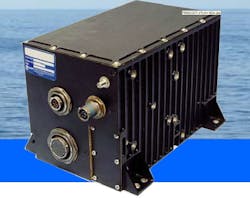Northrop Grumman to begin upgrading Kearfott navigation systems in MQ-8B/C Fire Scout UAVs
PATUXENT RIVER NAS, Md., 9 July 2014. U.S. Navy unmanned aerial vehicle (UAV) experts plan to upgrade navigation systems in the Northrop Grumman MQ-8B/C Fire Scout shipboard unmanned helicopters to improve the UAV's precision and reliability.
Officials of the Naval Air Systems Command at Patuxent River Naval Air Station, Md., announced plans Tuesday to award a test contract to the Northrop Grumman Corp. Aerospace Systems segment in Rancho Bernardo, Calif. Northrop Grumman is the Fire Scout's original manufacturer.
The upcoming contract will call for Northrop Grumman to test and qualify the Fire Scout navigation systems, which are made by the Kearfott Corp. Guidance & Navigation Division in Little Falls, N.J. Kearfott is a subsidiary of Astronics Corp.
The upcoming contract will have options to upgrade the Navy's inventory of the Kearfott navigation systems, which are fielded with the MQ-8B/C systems, to the -13 configuration.
Related: Navy issues urgent order to equip MQ-8 helicopter UAV with maritime surveillance radar
The MQ-8B/C Fire Scout unmanned helicopter uses two Kearfott KN-4073C systems as its prime navigation system. Kearfott engineers designed the KN-4073C as a small and lightweight navigation system for fixed-wing and helicopter UAVs. The system weighs 8 pounds.
The Kearfott KN-4073C uses the company's T-16B monolithic ring laser gyro (MRLG) and accelerometer triad coupled with an embedded SAASM P(Y) code Global Positioning System (GPS) receiver.
An April 2012 Fire Scout crash in Afghanistan was blamed on a faulty navigation system. Navy leaders briefly grounded the Fire Scout fleet and put tougher maintenance procedures in place. The unmanned helicopter was back in operation a few months later and has operated since then without serious incident.
The KN-4073C navigation systems on the Fire Scout has C/A code digital GPS corrections, and uses barometric altitude and true air speed as inputs. The system's navigation outputs consist of position and altitude, geographic velocities, true heading, roll and pitch, magnetic heading, and wind speed. The system's output flight-control outputs include angular rates and linear accelerations.
The system can guide the Fire Scout unmanned helicopter with inertial navigation alone, GPS alone, or most often with GPS and inertial navigation operating together. The KN-4073C can operate with the MIL-STD-1553B and RS-422 avionics databuses.
The Kearfott KN-4073C navigation systems aboard the Fire Scout can operate in temperatures from -45 to 71 degrees Celsius, meet MIL-STD-461E for electromagnetic interference resistance, and meet MIL-STD-810E/F for shock and vibration. The systems operate on 28-volt DC power and have convection cooling. The units measure 9.1 by 5.4 by 6 inches.
Related: Navy chooses RDRTec to develop common sense-and-avoid radar for Fire Scout and Triton UAVs
Navy officials say they plan to award the Fire Scout upgrade contract to Northrop Grumman sole-source because it would be too expensive and time consuming to open the project to competition.
Companies whose officials believe they could do the job as well and as economically as Northrop Grumman should contact the Navy's Eric Waterman no later than 23 July 2014 by email at [email protected], or by phone at 732-323-2559.
For more information contact Northrop Grumman Aerospace Systems online at www.northropgrumman.com, Kearfott Guidance & Navigation at www.kearfott.com, or Naval Air Systems Command at www.navair.navy.mil.

